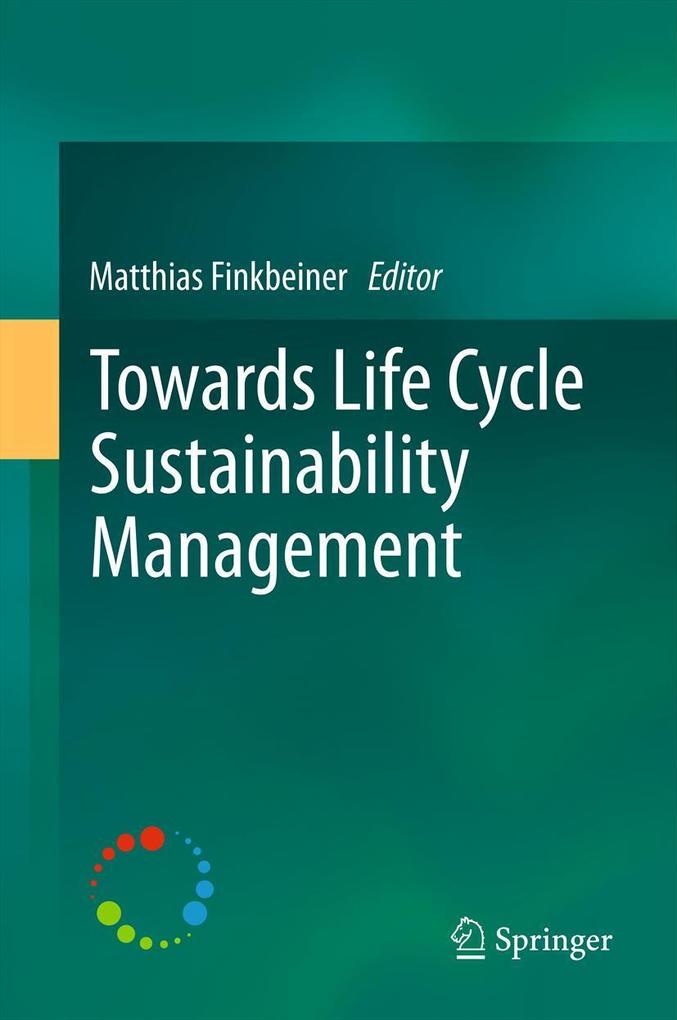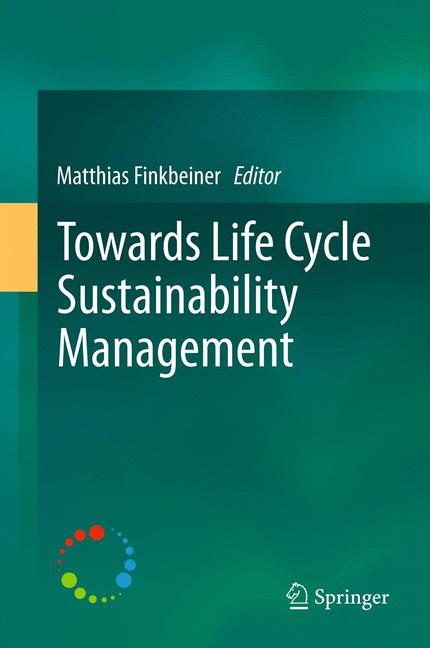
Zustellung: Sa, 12.07. - Di, 15.07.
Versand in 2 Tagen
VersandkostenfreiBestellen & in Filiale abholen:
Today's environmental focus on sustainability requires us to apply the principles of comprehensiveness and life cycle perspective in assessing sustainability itself. These papers, from the LCM 2011 conference, explore scientific and practical ways of doing so.
This book is a selection of the most relevant contributions to the LCM 2011 conference in Berlin. The material explores scientific and practical solutions to incorporating life cycle approaches into strategic and operational decision making. There are several sections addressing methodological topics such as LCSM approaches, methods and tools, while more application-oriented sections deal with the implementation of these approaches in relevant industrial sectors including agriculture and food, packaging, energy, electronics and ICT, and mobility.
Inhaltsverzeichnis
PART I: LCSM Approaches 1. Integrating Sustainability Considerations into Product Development: A Practical Tool For Prioritising Social Sustainability Indicators and Experiences From Real Case Application2. A Life Cycle Stakeholder Management Framework For Enhanced Collaboration Between Stakeholders with Competing Interests3. Stakeholder Consultation: What Do Decision Makers in Public Policy and Industry Want To Know Regarding Abiotic Resource Use? 4. Life Cycle Management Capability: An Alternative Approach To Sustainability Assessment5. The Sustainability Consortium: A Stakeholder Approach To Improve Consumer Product Sustainability6. A Social Hotspot Database For Acquiring Greater Visibility in Product Supply Chains: Overview and Application To Orange JuicePART II: LCM Methods and Tools 7. A Novel Weighting Method in LCIA and Its Application in Chinese Policy Context8. The Usefulness of an Actor s Perspective in LCA9. Review on Land Use Considerations in Life Cycle Assessment (LCA): Methodological Perspectives For Marine Ecosystems10. Visual Accounting 11. International Reference Life Cycle Data System(ILCD) Handbook: Review Schemes For Life Cycle Assessment12. Time and Life Cycle Assessment: How To Take Time Into Account in the Inventory Step? 13. A Method of Prospective Technological Assessment of Nanotechnological Techniques14. State of the Art Study - How Is Environmental Performance Measured For Buildings/Construction? PART III: Water Footprinting 15. Comparison of Water Footprint For Industrial Products In Japan, China and USA16. Assessment of the Water Footprint of Wheat in México17. Water Footprints in Four Selected Breweries in Nigeria18. Development and Application of a Water Footprint Metric For Agricultural Products and the Food Industry19. LCA Characterisation of Freshwater Use on Human Health and Through CompensationPART IV: LCM Of Processes and Organisations 20. How To Measure and Manage the Life Cycle Greenhouse Gas Impact of a Global Multinational Company21. Best Practice Application of LCM By Retailers To Improve Product Supply Chain Sustainability22. Life Cycle Management Approach To the Design of Large-Scale Resorts23. Greening Events: WasteReduction Through The Integration of Life Cycle Management Into Event Organisation at Esci24. Challenges For Lcas of Complex Systems: The Case of a Large-Scale Precious Metal Refinery Plant25. Life Cycle Inventory of Pine and Eucalyptus Cellulose Production in Chile: Effect of Process Modifications26. Life Cycle Assessment of the Integrated Solid Waste Management System of Delhi27. LCM of Rainwater Harvesting Systems in Emerging Neighborhoods in ColombiaPART V: LCM in the Agriculture and Food Sectors 28. Environmental Profiles of Farm Types in Switzerland Based on LCA29. The Use of Models to Account For the Variability of Agricultural Data30. Modular Extrapolation Approach For Crop LCA - MEXALCA: Global Warming Potential of Different Crops and Its Relationship to the Yield31. Regional Assessment of Waste Flow Eco-Synergy in Food Production: Using Compost and Polluted Ground Water in Mediterranean Horticulture Crops32. Assessing Management Influence on Environmental Impacts Under Uncertainty: A Case Study of Paddy Rice Production in Japan33. Assessing Environmental Sustainability of Different Apple Supply Chains in Northern Italy34. An Effect of CO2 Information Labeling For the Pork Produced With Feed Made From Food ResidualsPART VI: LCM In the Packaging Sector 35. Role of Packaging in LCA of Food Products36. Packaging Legislation and Unintended Consequences: A Case Study on The Necessity of Life Cycle Management37. Carbon Footprint of Beverage Packaging in the United Kingdom38. Enhanced Resource Efficiency With Packaging Steel39. Damage Assessment Model For Freshwater Consumption and a Case Study on PET Bottle Production Applied New Technology For Water Footprint Reduction. -PART VII: LCM in the Energy Sector. - 40. Sustainability Assessment of Biomass Utilisation in East Asian Countries41. Life Cycle Inventory of Physic Nut Biodiesel: Comparison Between the Manual and Mechanized Agricultural Production Systems Practiced in Brazil42. Life Cycle Assessment of Biodiesel Production From Microalgae Oil: Effect of Algae Species and Cultivation System43. Modeling the Inventory of Hydropower Plants Prioritising Social Sustainability Indicators and Experiences From Real Case Application44. Lifecycle Carbon Dioxide Emission and Stock of Domestic Wood Resources Using Material Flow Analysis and Life Cycle Assessment45. Analysis On Correlation Relationship BetweenLife Cycle Greenhouse Gas Emission and Life Cycle Cost of Electricity Generation System For Energy Resources46. Development and Application of a LCA Model For Coal Conversion Products (Coal To Y)PART VIII: LCM in The Electronics and ICT Sectors 47. European LCA Standardization of ICT: Equipment, Networks And Services48. Product Carbon Footprint (PCF) Assessment of a Dell Optiplex 780 Desktop Results and Recommendations49. State of the Art in Life Cycle Assessment of Laptops and Remaining Challenges On The Component Level: The Case of Integrated Circuits50. The Concept of Monitoring of LCM Results Based on a Refrigerator Case Study51. Life Cycle Management of F-Gas-Free Refrigeration Technology: The Case of F-Gases Free Frozen Dessert EquipmentsPART IX: LCM in the Mobility Sector 52. Assessment of the Environmental Impacts cf Electric Vehicle Concepts53. A Consistency Analysis of LCA Based Communication and Stakeholders Needs To Improve the Dialogue On New Electric Vehicles54. Design For Environment and Environmental Certificate at Mercedes-Benz Cars55. Implementing Life Cycle Engineering Efficiently Into Automotive Industry Processes56. Environmental Product Declaration of a Commuter Train Index
Produktdetails
Erscheinungsdatum
16. Oktober 2014
Sprache
englisch
Auflage
2011
Seitenanzahl
636
Herausgegeben von
Matthias Finkbeiner
Verlag/Hersteller
Produktart
kartoniert
Abbildungen
XLIV, 591 p.
Gewicht
949 g
Größe (L/B/H)
235/155/34 mm
Sonstiges
Previously published in hardcover
ISBN
9789401784610
Entdecken Sie mehr
Bewertungen
0 Bewertungen
Es wurden noch keine Bewertungen abgegeben. Schreiben Sie die erste Bewertung zu "Towards Life Cycle Sustainability Management" und helfen Sie damit anderen bei der Kaufentscheidung.










